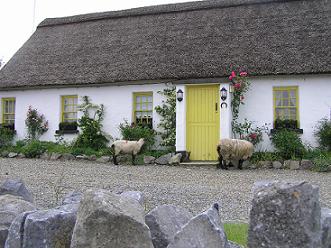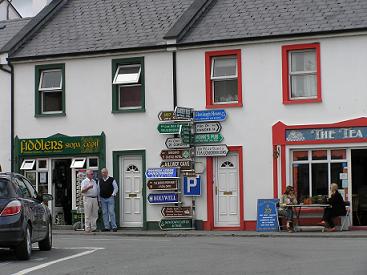Ballyvaughan...

Ballyvaughan is a coastal village near the northern border of County Clare Ireland. It is situated between the Burren hills and the southern edge of Galway Bay on the N67 and is 39km from Ennis. The village grew up around the harbour which was once a thriving port. The sheltered and picturesque bay makes it a popular port even nowadays, with a great variety of pleasure boats to be spotted. It is the first village you encounter on the Clare section of the Wild Atlantic Way and gives you a real taste of Clare's rugged beauty.
A castle site and a number of celtic ring forts in it surrounds show that this bay has been an important strategic point in the region from historic times. Today Ballyvaughan is one of the most important towns in the Burren region and together with Corofin Doolin Kilfenora and Gort forms one of the traditional edges of the Burren.
Ballyvaughan is a great spot to base oneself to tour North Clare.
There are many types of accommodation available in Ballyvaughan from hotels to bed and breakfasts and self-catering. The pubs in the region provide a variety of entertainment with traditional music being popular. The village is home to fine restaurants and beautiful craft shops.
Driving, cycling or hiking around Ballyvaughan offers a treasure of landscapes and seascapes. Between Ballyvaughan and Lisdoonvarna is the aptly named Corkscrew Hill. This terraced climbing road was designed as a famine relief scheme and has beautiful vistas along its route. On the coast are the unspoilt beaches of Bishops quarter and Fanore, from which you can view Black Island, Gall Island and Green Island. Bishops Quarter
is a picturesque strand, though stony in parts this long beach has stunning views across Galway Bay and of the Burren. The beach located few miles past the village on the R447 road from Ballyvaughan and is accessed by a narrow byroad which is signposted. There is ample car parking. Fanore beach is just a short senic drive from the village. The town boasts fantastic scenic views of the Burren Mountains, Newtown Castle and Aillwee Cave hill.

The famous Burren Way Walk starts in Ballyvaughan. The Burren Way is a marked and signposted walking route developed between Ballyvaughan and Lahinch. The route brings the walker inland from Lahinch, passing near the magnificent Cliffs of Moher, to Doolin and on to Ballinalackan. It then continues through the heartland of the Burren, mostly along Green Roads, across the Caher valley to Rathborney and, by the back route, on to Ballyvaughan. It brings the visitor through both the shale uplands of the southern Burren and the limestone pavements of the northern part. It may be traveled in either direction.
A large range of literature, maps and suggested walks in the Burren is available from the tourist information office located behind the Spar supermarket on the main street. Bike hire is also available in the village.
The valley in which Ballyvaughan is situated contains many celtic ring forts.Cahermore ring fort (the big fort) has stone walls that are up to nine feet high and it's lintelled doorway is still intact. Ballyallaban ring fort is an earthen fort which is unusual in the area as stone is so readily available.
Ballyvaughan is the arts and crafts centre of the county, the village has a gallery, craft shops, craft fair and an art college which is open to the public. The Burren College of Art is an internationally recognised not for profit charitable trust committed to the initial education of artists, and to their continuing professional development. The castle is restored and opened to the public. This towerhouse castle is unusual as it has a pyramidal base, there are 4 floors that can be visited, an art gallery and a cafe.
Just a few miles inland from Ballyvaughan is Ailwee Caves. The cave system consists of over a kilometre of passages leading into the heart of the mountain, its features include a frozen waterfall, stalactites and stalagmites. The centre has a tearooms, farm-shop, birds of prey demonstration, falconry and walks.